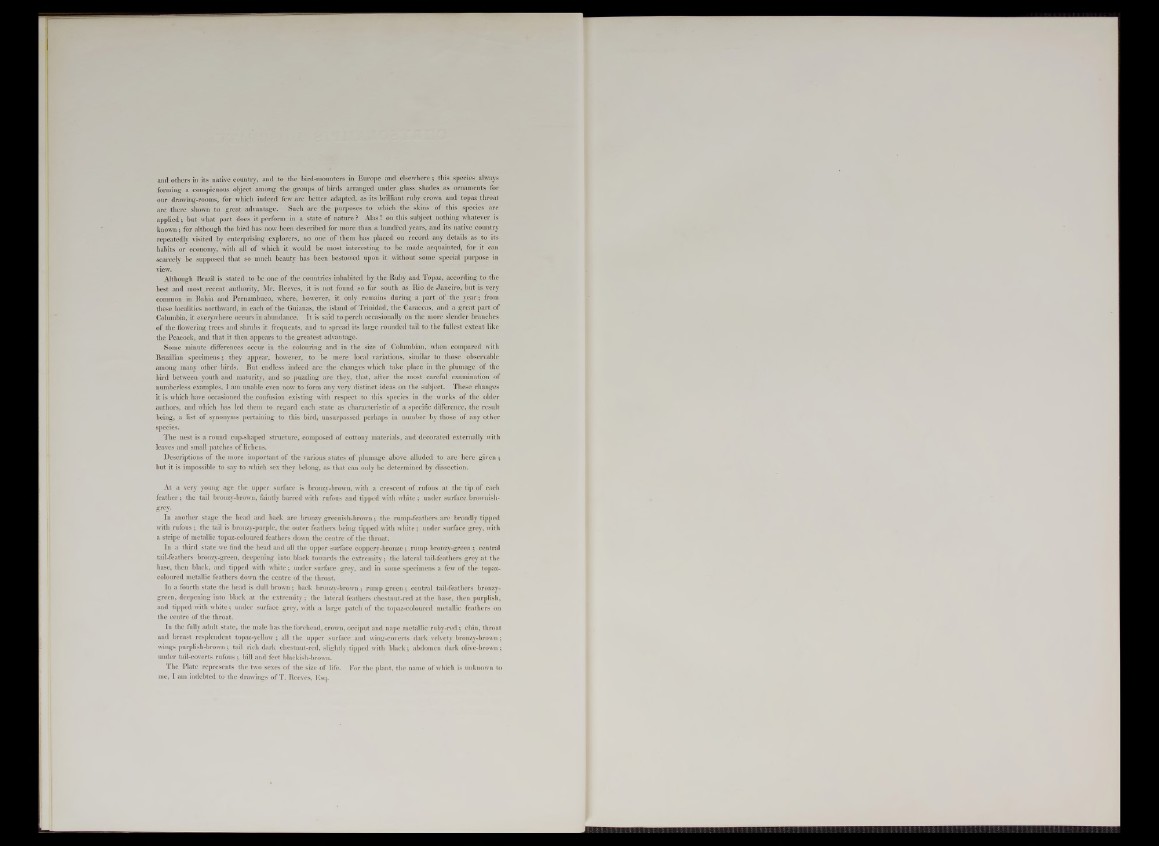
and others in its native country, and to the bird-mounters in Europe and elsewhere; this species always
forming a conspicuous object among the groups of birds arranged under glass shades as ornaments for
our drawing-rooms, for which indeed few are better adapted, as its brilliant ruby crown and topaz throat
are there shown to great advantage. Such are the purposes to which the skins of this species are
applied; but what part does it perform in a state of nature ? Alas! on this subject nothing whatever is
known; for although the bird has now been described for more than a hundred years, and its native country
repeatedly visited by enterprising explorers, no one of them has placed on record any details as to its
habits or economy, with all of which it would be most interesting to be made acquainted, for it can
scarcely be supposed that so much beauty has been bestowed upon it without some special purpose in
view.
Although Brazil is stated to be one of the countries inhabited by the Ruby and Topaz, according to the
best and most recent authority, Mr. Reeves, it is not found so far south as Rio de Janeiro, but is very
common in Bahia and Pernambuco, where, however, it only remains during a part of the year; from
these localities northward, in each of the Guianas, the island of Trinidad, the Caraccas, and a great part of
Columbia, it everywhere occurs in abundance. It is said to .perch occasionally on the more slender branches
of the flowering trees and shrubs it frequents, and to spread its large rounded tail to the fullest extent like
the Peacock, and that it then appears to the greatest advantage.
Some minute differences occur in the colouring and in the size of Columbian, when compared with
Brazilian specimens; they appear, however, to be mere local variations, similar to those observable
among many other birds. But endless indeed are the changes which take place in the plumage of the
bird between youth and maturity, and so puzzling are they, that, after the most careful examination of
numberless examples, I am unable even now to form any very distinct ideas on the subject. These changes
it is which have occasioned the confusion existing with respect to this species in the works of the older
authors, and which has led them to regard each state as characteristic of a specific difference, the result
being, a list of synonyms pertaining to this bird, unsurpassed perhaps in number by those of any other
species.
The nest is a round cup-shaped structure, composed of cottony materials, and decorated externally with
leaves and small patches of lichens.
Descriptions of the more important of the various states of plumage above alluded to are here given ;
but it is impossible to say to which sex they belong, as that can only be determined by dissection.
At a very young age the upper surface is bronzy-brown, with a crescent of rufous at the tip of each
feather ; the tail bronzy-brown, faintly barred with rufous and tipped with white ; under surface brownish-
grey.
In another stage the head and back are bronzy greenish-brown; the rump-feathers are broadly tipped
with rufous ; the tail is bronzy-purple, the outer feathers being tipped with white; under surface grey, with
a stripe of metallic topaz-coloured feathers down the centre of the throat.
In a third state we find the head and all the upper surface coppery-bronze; rump bronzy-green ; central
tail-feathers bronzy-green, deepening into black towards the extremity; the lateral tail-feathers grey at the
base, then black, and tipped with white; under surface grey, and in some specimens a few of the topaz-
coloured metallic feathers down the centre of the throat.
In a fourth state the head is dull brown; back bronzy-brown ; rump green ; central tail-feathers bronzy-
green, deepening into black at the extremity; the lateral feathers chestnut-red at the base, then purplish,
and tipped with white; under surface grey, with a large patch of the topaz-coloured metallic feathers on
the centre of the throat.
In the fully adult state, the male has the forehead, crown, occiput and nape metallic ruby-red ; chin, throat
and breast resplendent topaz-yellow; all the upper surface and wing-coverts dark velvety bronzy-brown;
wings purplish-brown; tail rich dark chestnut-red, slightly tipped with black; abdomen dark olive-brown ;
under tail-coverts rufous; bill and feet blackish-brown.
The Plate represents the two sexes of the size of life. For the plant, the name of which is unknown to
me, I am indebted to the drawings of T. Reeves, Esq.